#Second Battle of Fort Wagner
Photo









Milestone Monday
54th Massachusetts Infantry Regiment
On this day, July 18 in 1863, one of the first formal African American military units, the 54th Massachusetts Volunteer Infantry, supported by several white regiments, attempted an unsuccessful assault on Confederate-held Battery Wagner in what is known as the Second Battle of Fort Wagner. Despite the Confederate victory, the valor of the Black Union soldiers in the battle was hailed, strategically encouraging more African-Americans to enlist in Union regiments.
The 54th Massachusetts and this battle were most popularly memorialized by the 1989 Academy Award-winning film Glory, starring Matthew Broderick as the regiment’s white commander Colonel Robert G. Shaw (pictured above), and Denzel Washington, Morgan Freeman, Jihmi Kennedy, and Andre Braugher as members of the Black troops. A well-known monument by Augustus Saint-Gaudens on the Boston Common also memorializes Shaw and his regiment, and is part of the Boston Black Heritage Trail.
Curiously, Medal of Honor awardee Sergeant William Harvey Carney (also pictured above) is not depicted as a character in the movie Glory. During the Battle of Fort Wagner, Carney grabbed the U.S. flag as the flag bearer fell and rallied the troops by carrying the flag to the enemy ramparts and back, crying "Boys, the old flag never touched the ground!" The battle cry would later be turned into a song in Carney’s honor in 1900. This heroic action became the first for which the Medal of Honor was awarded to an African American.
In commemoration of this milestone, we present the second revised and corrected edition of History of the Fifty-Fourth Regiment of Massachusetts Volunteer Infantry, 1863-1865 by Captain Luis F. Emilio of the 54th, published in Boston by the Boston Book Company in 1894.
View more Milestone Monday posts.
#Milestone Monday#milestones#54th Massachusetts Volunteer Infantry#Civil War#American Civil War#African American troops#Black troops#regimental history#Second Battle of Fort Wagner#Robert G. Shaw#William Harvey Carney#Luis F. Emilio#African American History#History of the Fifty-Fourth Regiment of Massachusetts Volunteer Infantry
38 notes
·
View notes
Text
1863-Second Battle of Fort Wagner

One of the first formal African American military units, the 54th Massachusetts Volunteer Infantry, supported by several white regiments, attempts an unsuccessful assault on Confederate-held Battery Wagner.
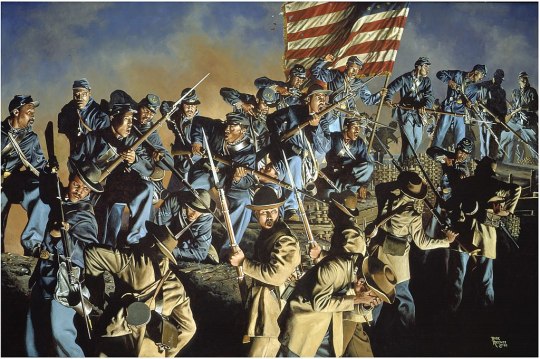
The Second Battle of Fort Wagner, also known as the Second Assault on Morris Island or the Battle of Fort Wagner, Morris Island, was fought on July 18, 1863, during the American Civil War. Union Army troops commanded by Brig. Gen. Quincy Gillmore launched an unsuccessful assault on the Confederate fortress of Fort Wagner, which protected Morris Island, south of Charleston Harbor. The battle came one week after the First Battle of Fort Wagner. Although a Confederate victory, the valor of the Black Union soldiers in the battle was hailed, which had long-term strategic benefits in encouraging more African-Americans to enlist allowing the Union to employ a manpower resource that the Confederacy could not emulate for the remainder of the war.

#Jul.18.1863#Second Battle of Fort Wagner#54th Massachusetts Infantry Regiment#American Civil War#Glory (1989 film)#history today
5 notes
·
View notes
Text
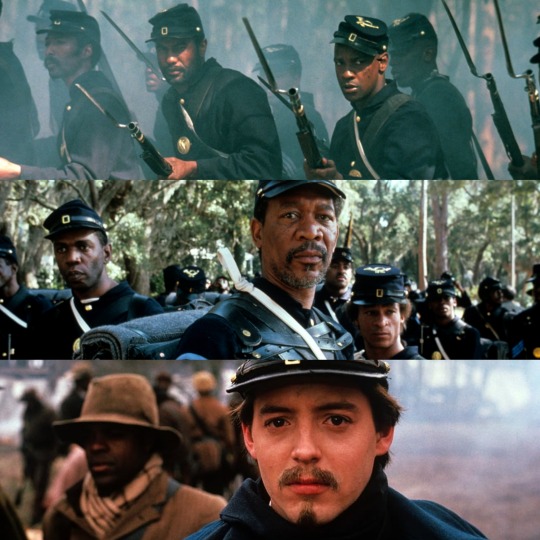
Glory (1989, Edward Zwick)
24/01/2024
Glory is a 1989 film directed by Edward Zwick about the first volunteer fighter unit formed by African Americans in the United Army during the American Civil War.
The film is inspired by the personal letters of Colonel Robert Gould Shaw, who led the 54th Massachusetts Volunteer Infantry Regiment from its formation in February 1863 until the attack on Fort Wagner in South Carolina, where he died during the assault in July of the same year.
Among the awards received, the film received five nominations for the 1990 Oscars, winning three as best supporting actor for Denzel Washington, best cinematography and best sound.
On September 17, 1862, during the American Civil War, Captain Robert Gould Shaw was slightly wounded during the Battle of Antietam and returned home to Boston on medical leave. During a ceremony in November of the same year, he met the abolitionist Frederick Douglass and at the request of Governor John Andrew, accepted the task of training and commanding with the rank of colonel the first regiment of African-American men of the Union Army.
The men are informed that due to President Lincoln's Emancipation Proclamation, the Confederacy has declared that all captured black Union soldiers will be returned to slavery and the white officers under their command shot.
In the subsequent clashes, the regiment gained the valor and respect of the white soldier and Shaw proposed himself to General George Strong as the first attack force on Fort Wagner, as part of the campaign to secure the port city of Charleston.
The officers are aware that breaking the fort's defenses will not be easy; in fact the fortress had previously been attack by a white regiment but without success (First Battle of Fort Wagner). A front-line force of the 54th, with supporting white companies, begins the Second Battle of Fort Wagner.
The film budget was $18 million and filming took place in Georgia and Massachusetts from February 9 to April 27, 1989.
Rotten Tomatoes indicates that 93% of 40 selected critics gave the film a positive review, with an average score of 7.9 out of 10.
#glory#film#1989#edward zwick#union#american civil war#Robert Gould Shaw#1863#south carolina#62nd Academy Awards#denzel washington#1862#Captain#Battle of Antietam#Boston#frederick douglass#John Albion Andrew#Military rank#Colonel#union army#emancipation proclamation#abraham lincoln#confederate states of america#George Strong#charleston south carolina#First Battle of Fort Wagner#Second Battle of Fort Wagner#georgia#massachusetts#rotten tomatoes
4 notes
·
View notes
Note
movie recs? movie recs please?
I have to be so honest with you when I say I don't have a particularly good or smart taste in movies, so like.... I'm going to give you 3 of my favorite movies. Clicking the titles should direct you to their respective doesthedogdie . com pages for lists of potential triggers.
• Spirit: Stallion of the Cimarron
Rated G, released in 2002
Set in the Old West in the late 19th century, the film follows Spirit, a mustang stallion, who is captured during the American Indian Wars by the United States Cavalry; he is eventually freed by a Lakota man named Little Creek with whom he bonds, as well as a mare named Rain.

• The Princess Bride
Rated PG, released in 1987
Adapted by William Goldman from his 1973 novel of the same name, it tells the story of a swashbuckling farmhand named Westley, accompanied by companions befriended along the way, who must rescue his true love Princess Buttercup from the odious Prince Humperdinck.

• Glory
Rated R, released in 1989 (Please review the trigger warnings with this movie.)
Glory is a 1989 American historical war drama film directed by Edward Zwick about the 54th Massachusetts Infantry Regiment, one of the Union Army's earliest African-American regiments in the American Civil War. It stars Matthew Broderick as Colonel Robert Gould Shaw, the regiment's commanding officer, and Denzel Washington, Cary Elwes, and Morgan Freeman as fictional members of the 54th.The film depicts the soldiers of the 54th from the formation of their regiment to their heroic actions at the Second Battle of Fort Wagner.
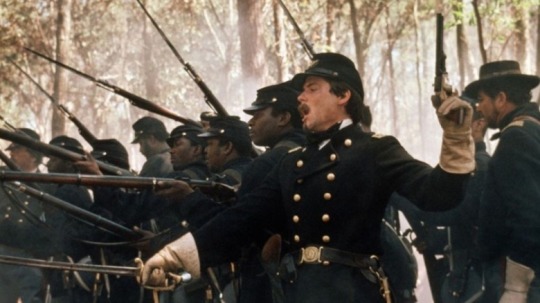
#i know these are basically not anything like one another I'm sorry#but um..... three different ratings to choose from#i appreciate this ask thank you#but seriously with glory- review the triggers#i highly recommend the movie it's something i think everyone should watch at least once but#it covers very serious topics like war + slavery + racism#there are racial slurs used in the film and graphic depictions of violence and (brief) gore
3 notes
·
View notes
Photo


Truman Seymour (September 24, 1824 – October 30, 1891) began his military career after attending Norwich University for two years before enrolling in the United States Military Academy in 1842. He graduated from West Point in 1846, and was assigned to the 1st Artillery during the outbreak of the Mexican-American War. He was promoted to first lieutenant for his conduct during the battles of Contreras and Churubusco. After the war, he returned to West Point and taught for three years, and then served during the Seminole War in Florida from 1856 to 1858.
When the Civil War broke out, Seymour was stationed in Fort Sumter, and was brevetted a major for his actions during the Confederate attack. His first service came early in the war within the defenses of Washington, and was promoted to brigadier general of volunteers on April 28, 1862. Seymour was assigned to a brigade within McCall’s division of the V Corps, commanded by John Porter. He commanded his soldiers during the battle of Mechanicsville, and then commanded the division during the battle of Malvern Hill as a result of McCall being captured by Confederates at the battle of Frayser’s Farm. He led troops during the battles of Second Manassas, South Mountain, and Antietam, resulting in two brevet promotions in the regular army up to colonel. In November of 1862, he was reassigned to Charleston Harbor and led a failed attack on Battery Wagner in July of 1863, where he was severely wounded.
When Seymour returned to duty in December of 1863, he was placed in charge of the District of Florida by General Quincy A. Gillmore. In February of 1864, Seymour and his division made an expedition to Florida capturing the city of Jacksonville. On February 20, Seymour and his division left the city and met approximately 5,000 Confederate troops under the command of Joseph Finegan at the battle of Olustee. The battle would be the largest battle fought in Florida during the Civil War, and ultimately a Confederate victory. Seymour’s defeat resulted in his retreat back to Jacksonville. Following the battle he was relieved of command of the division in Florida, and sent to Virginia where he was placed within the Army of the Potomac.
He served during the battle of the Wilderness, and was captured by Confederate forces under John B. Gordon. He was exchanged after the battle, and was placed in charge of the third division of the VI Corps. He commanded through Union campaigns in the Shenandoah Valley, during the siege of Petersburg, and finally during the Appomattox campaign. He was present when Robert E. Lee surrendered to Ulysses S. Grant, and received brevet promotions of major general of volunteers and brigadier general in the regular army for his actions during the final campaigns of the war.
#truman seymour#american civil war#civil war#history#my dude went through some tough times lol#but i mean...he ended up sticking with the VI corps for the rest of the war#that's a+ the VIs corps is fantastic
6 notes
·
View notes
Video
youtube
1863 Second Battle of Fort Wagner at Civil War | Historical Cinematic Ba...
1 note
·
View note
Text

Glory Is One Of The Finest Civil War Films Ever Made
Matthew Broderick, Denzel Washington, and Morgan Freeman starred in 1989's Glory, about the Union Army's first African American regiment during the Civil War. The film was partially based on the personal letters of Colonel Robert Gould Shaw (Broderick) during the Second Battle of Fort Wagner.
The film earned a 93 percent rating on Rotten Tomatoes, with critics saying, "Bolstered by exceptional cinematography, powerful storytelling, and an Oscar-winning performance by Denzel Washington, Glory remains one of the finest Civil War movies ever made." American Civil War historian James M. McPherson believes it's one of the most accurate Civil War on-screen depictions.
youtube
1 note
·
View note
Text
Events 8.16 (before 1900)
1 BC – Wang Mang consolidates his power in China and is declared marshal of state. Emperor Ai of Han, who died the previous day, had no heirs.
942 – Start of the four-day Battle of al-Mada'in, between the Hamdanids of Mosul and the Baridis of Basra over control of the Abbasid capital, Baghdad.
963 – Nikephoros II Phokas is crowned emperor of the Byzantine Empire.
1328 – The House of Gonzaga seizes power in the Duchy of Mantua, and will rule until 1708.
1513 – Battle of the Spurs (Battle of Guinegate): King Henry VIII of England and his Imperial allies defeat French Forces who are then forced to retreat.
1570 – The Principality of Transylvania is established after John II Zápolya renounces his claim as King of Hungary in the Treaty of Speyer.
1652 – Battle of Plymouth: Inconclusive naval action between the fleets of Michiel de Ruyter and George Ayscue in the First Anglo-Dutch War.
1777 – American Revolutionary War: The Americans led by General John Stark rout British and Brunswick troops under Friedrich Baum at the Battle of Bennington in Walloomsac, New York.
1780 – American Revolutionary War: Battle of Camden: The British defeat the Americans near Camden, South Carolina.
1792 – Maximilien de Robespierre presents the petition of the Commune of Paris to the Legislative Assembly, which demanded the formation of a revolutionary tribunal.
1793 – French Revolution: A levée en masse is decreed by the National Convention.
1812 – War of 1812: American General William Hull surrenders Fort Detroit without a fight to the British Army.
1819 – Peterloo Massacre: Seventeen people die and over 600 are injured in cavalry charges at a public meeting at St. Peter's Field, Manchester, England.
1841 – U.S. President John Tyler vetoes a bill which called for the re-establishment of the Second Bank of the United States. Enraged Whig Party members riot outside the White House in the most violent demonstration on White House grounds in U.S. history.
1858 – U.S. President James Buchanan inaugurates the new transatlantic telegraph cable by exchanging greetings with Queen Victoria of the United Kingdom. However, a weak signal forces a shutdown of the service in a few weeks.
1859 – The Grand Duchy of Tuscany formally deposes the exiled House of Lorraine.
1863 – The Dominican Restoration War begins when Gregorio Luperón raises the Dominican flag in Santo Domingo after Spain had recolonized the country.
1869 – Battle of Acosta Ñu: A Paraguayan battalion largely made up of children is massacred by the Brazilian Army during the Paraguayan War.
1870 – Franco-Prussian War: The Battle of Mars-la-Tour is fought, resulting in a Prussian victory.
1876 – Richard Wagner's Siegfried, the penultimate opera in his Ring cycle, premieres at the Bayreuth Festspielhaus.
1891 – The Basilica of San Sebastian, Manila, the first all-steel church in Asia, is officially inaugurated and blessed.
1896 – Skookum Jim Mason, George Carmack and Dawson Charlie discover gold in a tributary of the Klondike River in Canada, setting off the Klondike Gold Rush.
0 notes
Text
History
July 19-20, 1848 - A women's rights convention was held at Seneca Falls, New York. Topics discussed included voting rights, property rights and divorce. The convention marked the beginning of an organized women's rights movement in the U.S.
July 19, 1863 - During the American Civil War, Union troops made a second attempt to capture Fort Wagner near Charleston, South Carolina. The attack was led by the 54th Massachusetts Colored Infantry, commanded by Colonel Robert Gould Shaw, who was killed along with half of the 600 men in the regiment. This battle marked the first use of black Union troops in the war.
Birthday - French impressionist painter Edgar Degas (1834-1917) was born in Paris. Best known for his paintings of dancers in motion.
0 notes
Photo

UNIT PROFILE – 54TH MASSACHUSETTS VOLUNTEER INFANTRY REGIMENT The Emancipation Proclamation’s promulgation in 1863 opened the Union Army’s ranks to Black soldiers for the first time, allowing Black Americans to fight for the Union’s preservation and the end of slavery. The 54th Massachusetts Volunteer Infantry Regiment was among the first all-Black units to be stood up. Led by COL Robert Gould Shaw (scion of a prominent abolitionist family) and promoted by prominent figures like Frederick Douglass, the 54th was flooded with recruits. Despite Confederate promises to punish captured Black soldiers and their white officers with summary execution for promoting “servile insurrection,” the 54th marched to war in high spirits, leaving Boston on 28 MAY. From 18 – 19 JUL the Union began operations to capture Fort Wagner (a critical part of the harbor defenses of Charleston, South Carolina) following an early unsuccessful attack from 10 – 11 JUL. Deploying a force of 5,000 infantry in a frontal assault, the Union placed the 54th in the vanguard of the attack force, sending them charging across an open field towards Ft. Wagner under withering rifle and artillery fire rained on them by the 1,800 Confederate defenders. COL Shaw led the 54th up the fortifications, rallying his men with a cry of “Forward Fifty-Fourth!” from atop the ramparts before being killed. Despite their commander’s death the 54th pushed on, engaging the rebels in bitter hand-to-hand fighting. Despite 54th’s best efforts, the Union was unable to break through the fort’s defenses; the 54th paid an exorbitant price for its extraordinary valor, suffering a staggering 42% casualty rate (280 of the 600 of its men who fought in the Second Battle of Ft. Wagner). The stories of the 54th’s heroism quickly spread across the Union, motivating Black Americans to enlist in the U.S. Army. Between 1863 and 1865 nearly 200,000 Black soldiers served the cause of liberty, contributing roughly 10% of the U.S. Army’s Civil War manpower. #Armyhistory #USArmy #TRADOC #CivilWar #CivilWarHistory #ArmyHeritage #MilitaryHistory #BlackHistoryMonth #54thmassachusetts Posted @withregram • @armyhistory (at Army Recruiting Columbia, TN) https://www.instagram.com/p/CocK6HVutK2/?igshid=NGJjMDIxMWI=
#armyhistory#usarmy#tradoc#civilwar#civilwarhistory#armyheritage#militaryhistory#blackhistorymonth#54thmassachusetts
0 notes
Photo

The Hagley Library is honoring Juneteenth today with these photographs of members of the 54th Massachusetts Infantry, a regiment of black federal troops, at the Second Battle of Fort Wagner. The regiment began recruiting shortly after the issuance of the Emancipation Proclamation on January 1, 1863.
Initially, many white Americans in the Union states were uneasy with and doubtful about the black soldiers of the 54th regiment ability to serve. But white abolitionists and black Americans actively recruited for their ranks. Two of Frederick Douglass's sons were early enlistees, the black abolitionist Major Martin Robison Delany and black war correspondent George E. Stephens worked to recruit enlistees, and Robert Gould Shaw, the son of two white Boston abolitionists, was appointed to command the regiment as its Colonel by Massachusetts Governor John Albion Andrew, an antislavery advocate who had long been a leading force in enlisting black volunteer enlistees to serve as uniformed soldiers in the Union Army.
While the over 1,500 soldiers and officers that served in the 54th Massachusetts Infantry would come to conduct themselves in the Civil War with distinction throughout its extensive service, the regiment is most famous for its valor in the Second Battle of Fort Wagner, fought on July 18th, 1863 at Morris Island, South Carolina.
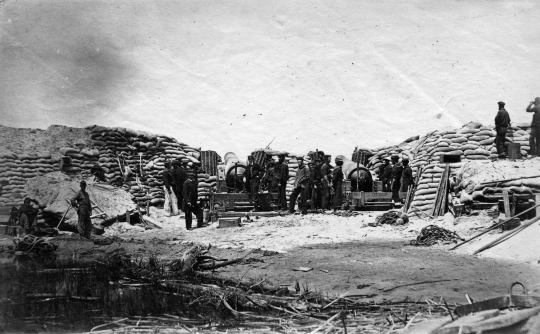
After the regiment was tasked with leading the assault on Fort Wagner, Colonel Shaw was killed in battle along with 29 men of the 54th. An additional 149 men from the regiment were wounded, and 91 were captured, later died of wounds from the battle, or were declared missing in action. While Union forces were ultimately unable to capture Fort Wagner, the 54th received wide acclaim for their conduct during the battle, and their reputation spurred the enlistment of other African-American volunteer soldiers and helped substantially to improve white Northerners’ opinion of black soldiers and the prospect of emancipation. One member of the regiment that was among the wounded, Sgt. William Carney, born into slavery in 1840, was awarded the Medal of Honor on May 23, 1900.

These photographs are from the Hagley Library’s Civil War officers photographs (Accession 1971.MSS.918). To view more items from this collection via our Digital Archive, click here. These items were digitized in conjunction with Hagley’s exhibit, An Oath of Allegiance to the Republic: the du Ponts and the Civil War. Click here to view the online exhibit.
#Juneteenth#Second Battle of Fort Wagner#Emancipation Proclamation#American Civil War#54th Massachusetts Infantry#1860s#Robert Gould Shaw#black soldiers#Frederick Douglass#South Carolina history#Morris Island#Sgt. William Carney#Medal of Honor#June 19#John Albion Andrew
17 notes
·
View notes
Photo


TODAY IN HISTORY
18 July 1863
The Second Battle of Fort Wagner
“After the July 11 assault on Fort Wagner failed, Gillmore reinforced his beachhead on Morris Island. At dusk July 18, Gillmore launched an attack spearheaded by the 54th Massachusetts Infantry, a black regiment. The unit’s colonel, Robert Gould Shaw, was killed. Members of the brigade scaled the parapet but after brutal hand-to-hand combat were driven out with heavy casualties. The Federals resorted to siege operations to reduce the fort. This was the fourth time in the war that black troops played a crucial combat role, proving to skeptics that they would fight bravely if only given the chance.”
53 notes
·
View notes
Text

Colonel Robert Shaw started his military life as a Private in the 7th New York Militia and end it in charge of the 54th Infantry Regiment an all black unit.
He was killed 18 July 1863 during the Second Battle of Fort Wagner. It was customary to return the bodies of fallen officers to their side after battles, in this case the bodies of General George Crockett Strong, Colonel Haldimand S. Putnam and Colonel John Lyman Chatfield were returned by the forces led by Confederate General Johnson Hagood, Hagood's forces burred Colonel Shaw's remains in a mass grave with those of his men as in insult for leading black Soldiers.
'Hagood told a captured Union surgeon that "Had he [Shaw] been in command of white troops ..." he would have returned Shaw's body, as was customary for officers, instead of burying it with the fallen black soldiers.
'But it had the opposite effect, becoming a point of pride for those who knew Colonel Shaw.
"In a letter to the regimental surgeon, Lincoln Stone, Frank Shaw (Colonel Shaw's father.) wrote:
We would not have his body removed from where it lies surrounded by his brave and devoted soldiers. ... We can imagine no holier place than that in which he lies, among his brave and devoted followers, nor wish for him better company. – what a body-guard he has!"After the war, the Union Army disinterred and reburied all the remains—including, presumably, those of Col. Shaw—at the Beaufort National Cemetery in Beaufort, South Carolina. Their gravestones were marked as "unknown".
Colonel Shaw was 24.
49 notes
·
View notes
Text
I always love the reply of Frank Shaw, the father of Robert Gould Shaw, colonel of the 54th Massachusetts regiment, the first black regiment in the US army, after he was told that his son was killed at the second battle of Fort Wagner and was buried with his soldiers in what the Confederates thought was an insult:

We would not have his body removed from where it lies surrounded by his brave and devoted soldiers. ... We can imagine no holier place than that in which he lies, among his brave and devoted followers, nor wish for him better company. – what a body-guard he has!
33 notes
·
View notes
Photo

548 notes
·
View notes
Photo
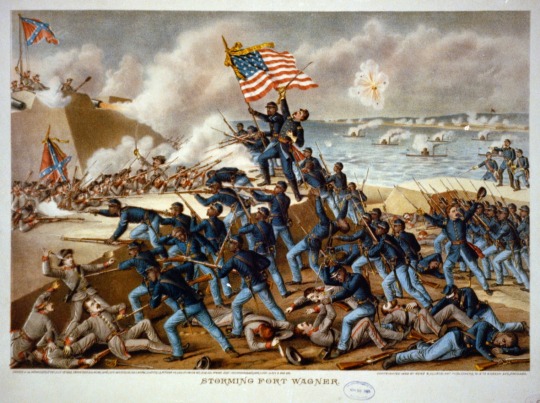
The Glory Regiment By Rachel Dworkin, archivist
What do Denzel Washington, Mathew Broderick, and Elmira have in common? The 54th Massachusetts Volunteer Infantry! Formed in February 1863, the regiment was the second African-American regiment formed in the north and by far the most famous. They participated in operations around Charleston, South Carolina, including the Second Battle of Fort Wagner (July 18, 1863), and in the Battle of Olustee (February 20, 1864) in Florida. Twenty-four Chemung County residents, mostly from Elmira with two from Horseheads, served in the regiment. (READ MORE)
16 notes
·
View notes